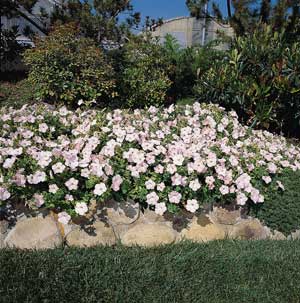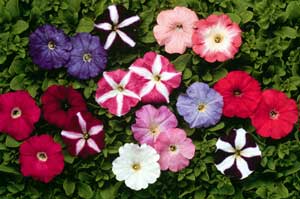 |
| Pink Wave Petunias |
Petunias are a favorite flower for residential yards and gardens. Typical of annual flowers, they provide jaunty color during the long growing season and require little care in return. Garden petunias come in over 200 different hybrid versions in a wide variety of colors and shapes.
Petunias are called annuals because their roots are not able to withstand the cold winters in the North and they are killed by hard frost when it arrives at the end of the season. However, better than many more tender annuals, they are able to handle some chill, especially if they are located near a stone or brick wall which retains some heat after a sunny day. They may bloom sparsely after a light frost and enjoy a bit of Indian summer in the late fall.
Description of Petunias
Size: There are hundreds of petunia hybrids and they are usually organized by the size of the blossom. The size of these plants can range from 6 inches tall up to two feet tall depending on the particular variety. Some have trailing or cascading forms that grow along the ground or hang over the edge of a container rather than grow upright.
Foliage: Petunia foliage is pale to medium green. Individual leaves are soft and hairy. They are shaped like elongated ovals with rounded or slightly pointed tips and smooth edges. They may be from 2 to 4 inches long and 3/4 to 1 inch wide. Sometimes they are a little sticky. They grow along the lower stems in an alternating pattern, but as they reach the tips they tend to grow opposite each other.
 |
Flowers: While the traditional familiar petunia blossom is single and shaped like a trumpet with smooth or fluted petals, modern hybrids feature double flowers, as well as ruffled and fringed ones. Various types of petunias have blossoms from 2 to 7 inches in diameter.
Grandifloras have either single or double flowers 4 to 5 inches across. These blooms can be messed up with heavy rain. Multifloras have smaller flowers coming in at about 2 inches across. These are much more resistant to weather damage. Then there are multifloras with smaller 1 inch to 1 1/2 inch blooms. Finally, there are “groundcover” petunias with 1 to 2 inch blooms. These include the very popular ‘Wave’ and ‘Surfinia’ series.
Petunias come in red, shades of pink, scarlet, purple, many shades of blue, yellow, white, orange, and lavender. Some are bicolored, having stripes and veins with darker or contrasting colors. While all are not noted for their fragrance, some kinds of petunias--especially purple, rose, and blue ones-- have a pleasant, light cinnamon scent.

